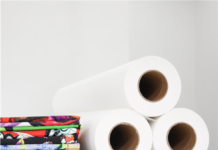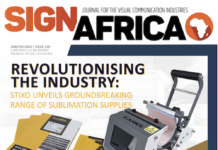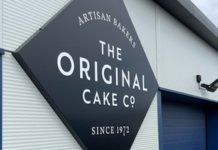According to Ken Tamashiro, writing for SignCraft, you don’t have to master all of Photoshop’s features to create great lettering effects. This article appears in Sign Africa Journal.
I do most of my sign layouts for printed graphics in Photoshop — it’s a very powerful tool for sign makers. One of the main reasons is that I like to use the unique effects on the lettering that Photoshop makes possible. Very realistic bevels, inset centres, gold leaf, blends, unusual outlines — all this and more are possible if you invest a little time in learning how to use Photoshop.
And you don’t have to learn Photoshop inside and out to start creating these effects. As sign designers, we work primarily with lettering. We don’t usually use Photoshop’s powerful photo editing features, because we’re not retouching an image of a mountain. Usually we are designing great-looking primary copy for a sign for Acme Masonry or Total Fitness. Here are five tips that will shorten your learning curve and have you turning out beautiful lettering effects in no time:
1. Work in layer styles
For lettering, this is the easiest way to go. Plus, you can save the lettering effects you create to use on or modify future projects. Before long you will have a terrific library of effects that you can use with just a click. Rather than work in layers where there would be a separate layer for the outline, the shadow and the colour fade, Layer Styles lets you do this in one style, and save it. With practice and experimentation, you can build layer styles for all sorts of incredible effects, like chrome, gold, engine turned, gold leaf with matte centres and many more.
2. Colour calibrate your monitor
I use a ColorMunki Display to calibrate my monitor. Colour calibration ensures that what you see on the screen will be what you get when you print. Without calibration, you will be making a lot of test prints and a lot of adjustments to your design. When you know that what you see will be what you get, though, you can design with a lot more confidence.
3. Work and print in RGB
There’s a tendency to think that since the printer has CMYK cartridges that you should do your designs in CMYK mode. I find working in RGB gives much more accurate output. In my experience, working in CMYK results in prints that look a little dirty. RGB gives you brighter, vibrant prints. I outsource my printing to a shop that prefers RGB titles, submitted in JPG format.
4. Master the type tool
Invest a little time in learning all that you can do with Photoshop’s type tool. Watch a few videos and read a few online articles. Text is the fundamental reason for most sign work so you need to be proficient with this, too.
5. Output at 300dpi
For signs, I use 300dpi resolution. It gives you a much higher quality output. For a banner, I would use 150dpi resolution. I learnt a lot about using layer styles from the Photoshop WOW! Book by Jack Davis and I’m sure there are other books like it to help you get started. One minor limitation you should be aware of is that Photoshop rounds the corners of the outline. If the customer insists on perfectly square corners, you’ll have to do that design in Adobe Illustrator, and export it using ‘Save as PDF (or EPS)’.
Back in the Photoshop layout, use the Place command, which is a special command for importing files. Photoshop can help you create incredible printed lettering and graphics with powerful visual appeal — especially for customers. Selling upgraded graphics is easy when you can show the dramatic difference they can make.
Reprinted with permission from SignCraft Magazine www.signcraft.com
















